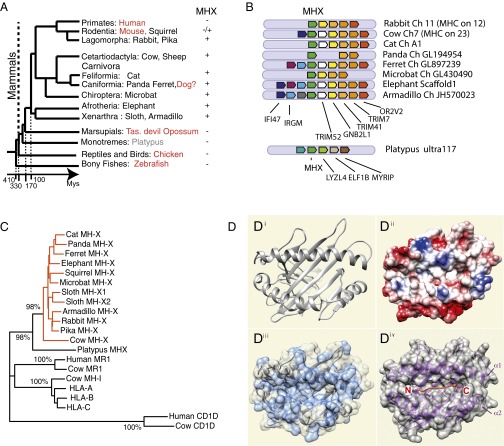Fig. 5.
MHX is a previously unidentified MH1Like gene found across mammals. (A) Schematic representation of phylogenetic relationships between the main groups of mammals. Species in which no functional MHX was found are shown in red. Note that the time scale is not linear. (B) MHX gene is located in a conserved genomic context across eutherians, whereas the related sequence from the platypus is not in the same microsynteny gene set. (C) Phylogenetic analysis (NJ, pairwise deletion, bootstrap: n = 1,000) shows that MHX genes constitute a distinct branch of MH1Like sequences. (D) Molecular modeling of rabbit MHX α1-α2 region. (D, i) Ribbon diagram of rabbit MHX based on the structure of H-2Kb. By convention, the α1 helix is at the top of the top view, placing a potential peptide N terminus to the left. (D, ii) Coulombic surface coloring (red is positive, and blue is negative); the groove is open on the side of the peptide N terminus as for a MH2 molecule and closed on the side of the peptide C terminus as for an MH1 molecule, but it is neutral. (D, iii) Surface hydrophobicity of the α1 and α2 domains (blue) showing that the C-terminal part of the groove is hydrophobic. (D, iv) For comparison, ribbon and surface representations of the α1-α2 domains of H-2Kb showing how the peptide is accommodated in a groove that is closed at the peptide N and C termini.

